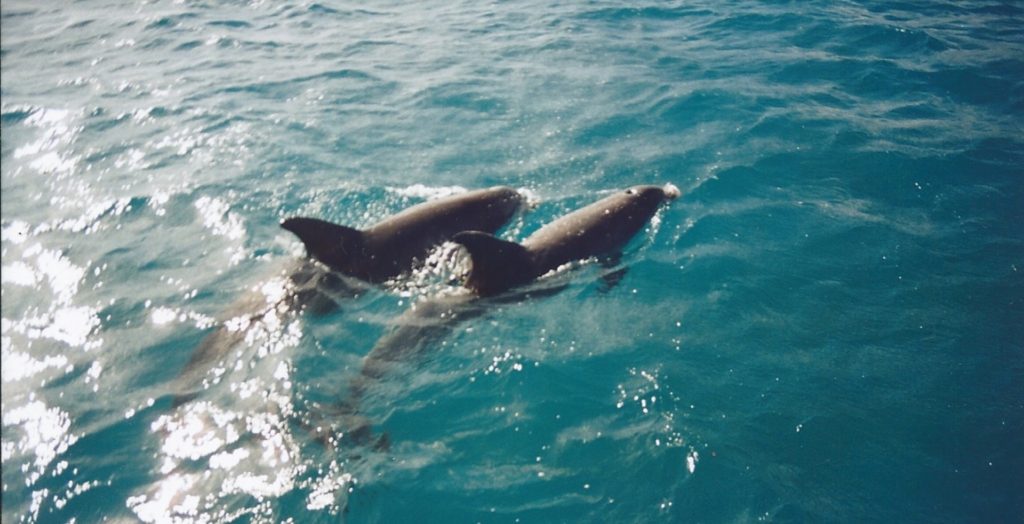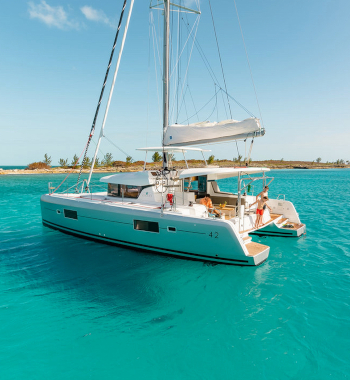Sailing with Dolphins
By Claudia Colli
The bottlenose dolphin is the most commonly sighted species in the British Virgin Islands. So it wasn’t surprising that when I was sailing in the BVI one day, I spotted one. Or to be more accurate – several.
I was sailing with my two sons and husband along the south shore of Jost Van Dyke when we saw them. There were seven dolphins in all, in a variety of sizes – and I soon realized that it was likely an extended family. Two sets of adults were swimming in pairs and just beyond them, but never out of their sight, were three juveniles swimming and playing in a tight band. A tangle of small heads and fins, the youngsters tumbled over one another like a group of toddlers roughhousing in a playpen.

It wasn’t the first time I had seen dolphins in BVI waters. I had spotted one or two while out on previous sailing trips and had seen them perform in aquariums. But watching these sleek and intelligent creatures in the wild was thrilling. Natural and relaxed, they, like us, were enjoying a family outing: basking in the beauty of the day and thrilled to see people up close – or so I imagined.
We kept company for almost an hour. The adults, in perfect unison, would glide alongside the boat and occasionally dive beneath the port hull. A mist of water would spray up from their spouts as they gracefully emerged starboard; and although the calves continued to romp, they never strayed far away. Finally, they headed down the channel to resume their private lives, and we sailed into Great Harbor. While we were sad to see them go, we were delighted to share a portion of our day with them.
The bottlenose dolphin is prevalent throughout the Caribbean and other areas of temperate-tropical to tropical waters world-wide. The largest of the dolphin species, the bottlenose may reach over nine feet in length and a hefty 440 pounds in weight.

Like all bottlenose dolphins, the animals that we observed that day, had a short stubby beak, a lower jaw that protrudes farther than the upper jaw and a crease where forehead and snout meet. Their bodies, medium gray on top and lighter gray below, were stocky and the dorsal fin located slightly behind the middle part of their body was tall and curved. Our sailing companions seemed amazingly personable, the type of animals (despite their formidable size) that made me want to pick them up and give them a hug.
A small toothed whale, dolphins are part of the order cetacean, which includes whales, dolphins, porpoises and narwhals. Porpoises are sometime confused with dolphins, but have a blunt snout and have teeth that are spade shaped rather than cone shaped like those of the dolphin.
Like all cetaceans, dolphins are mammals and need to maintain a high body temperature (about 97.9 to 99 degrees Fahrenheit) and breathe air, which is accomplished through a specialized single nostril or blowhole located at the top of the head. This need for air – about every two minutes or so – is why we so often see them at the surface. As mammals, dolphins also give birth to live young, a single calf at a time. Courtship begins in the spring and gestation is between 11 and 12 months.
The mammal dolphin though, is not to be confused with the dolphin that is a fish. Popular with sport fishermen, this dolphin is also known as the dorado and is commonly referred to as “mahi mahi” on restaurant menus.
Dolphins eat mostly open water fish such as herring, mackerel and sardines, with a large nine-foot long dolphin eating up to 66 pounds a day. Although dolphins can roam widely they tend not to stray too far into open sea and like to stay where the food is most plentiful.
Dolphins are quick. Capable of sustaining speeds of 18 miles per hour, they can swim as fast 25 miles per hour for short bursts. “Our” dolphins cruised alongside our sailboat as if they were on a Sunday stroll, easily keeping up with us at a leisurely six or seven knots, and probably wondering why we didn’t step on the gas.
In television programs like the classic 1960s series, Flipper and in movies such as the action thriller, The Day of the Dolphin, they are seen as smart, savvy and a friend to human beings. The reality is more complex. Although dolphins are considered intelligent creatures by many, it can be hard to tell exactly how smart they really are. Fast learners, they can be taught complicated language-like commands. But although their intelligence is believed to be greater than that of dogs and comparable to some primates, it is not considered to be equal to that of human beings. Because dolphins live in a totally different world from us and perceive that world differently, some scientists believe that it is not so much a matter of equivalence or superiority, but more a matter of what the dolphin does with its brain.
Dolphins use a sophisticated method of communication, primarily through whistles and clicks, and it is thought by some researchers that they give each other names or signature sounds to identify each other. Their high-pitched clicks are used as a form of sonar. Known as echolocation, the sound bounces off an object sending back an echo which allows the dolphin to estimate the distance of the object. It is believed by some scientists that dolphins may also use these sounds to deliver an acoustic shock in order to stun or kill small prey.
Through a specialized whistle or squeal, these highly vocal creatures can communicate an emotional state to other dolphins, such as alarm or sexual excitement. In addition to sounds, they communicate by breaching (jumping and falling back into the water), slapping the water with their fins or tails, body posturing and jaw popping. Even more impressive, is their ability to mimic some human sounds.

Although I like to think that the dolphins we saw were part of a single family, there is no way of knowing for sure. In some species, up to 1,000 animals travel together, but others such as the bottlenose are found in smaller clusters of less than 100, or in small family groups. Individuals are rare, although on occasion, a solitary dolphin has been sighted around the BVI. In one instance, a lone dolphin found its way to several of Tortola’s most popular anchorages, thrilling kids and adults alike. Was it seeking out social interaction? Although one can’t tell for sure, to observers, it seemed likely.
While dolphin families are the norm, what comprises a family may vary. In field observations, dolphins have shown that they bond with infants other than their own, and that they don’t form permanent pair bonds. It is also possible that, like in our society, these personable mammals don’t form just a simple set of family ties, but create friendships and associations beyond the family.
One of the greatest dangers to dolphins in recent times has occurred when large numbers become entangled in tuna fishing nets. Those that survive the rigors of a life time at sea can reach the ripe old age of 40 to 50 years.
It is exciting to sight dolphins when at sea, but certain rules should apply. Like any wild animal it is best to watch them from a distance. You shouldn’t pursue them nor feed them since human food may lack the nutrition they require.
A lot more research needs to occur before we finally understand dolphins, their intelligence and their social structure. But a lot can also be learned by a chance encounter with a dolphin family on an outing in the Virgin Islands.
For more about Caribbean dolphins and other cetaceans go to:






